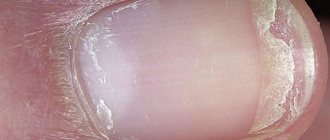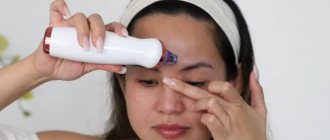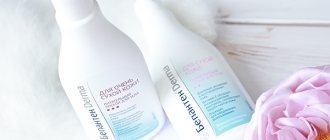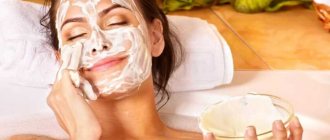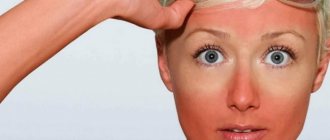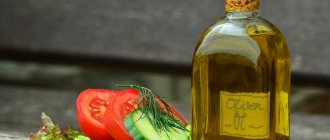Signs and origins of oily facial skin
Oily skin is the result of overproduction of oil by the sebaceous glands. These glands are located under the surface of the skin.
Sebum is a substance made up of fats. It's not too bad as it protects and moisturizes the skin and keeps the hair on your head shiny and healthy.
Too much sebum, however, can lead to oily skin, which can lead to clogged pores and acne.
The occurrence of comedones (blackheads), fatty gland cysts, and seborrhea is also not uncommon. The skin is similar to an orange peel because it has pores.
An undeniable advantage for people with oily skin is that wrinkles begin to appear later.
The epidermis shiny from grease is an unpleasant phenomenon for its owners. Due to the excessive work of the fat glands, a rough, porous texture with an unhealthy tone and a greasy sheen is formed on the skin; the surface of the skin can be overdried, like parchment.
Genetics, hormonal changes, or even stress can increase sebum production.
Oily tissue on the face is localized in the T-zone: forehead, chin and nose. On the body, the greasy epidermis is located on the back and chest. The properties of oily skin also appear on oily hair on the head.
This happens for the following reasons:
- Genetically determined. Under these circumstances, the epidermis is oily throughout life.
- Adolescence. Teenagers are familiar with the manifestations of oily skin, which by the age of 25-30 becomes combination.
- Intensive work of fat glands. This is associated with an inherited predisposition to oily skin, disrupted processes in the gastrointestinal tract (cholecystitis, colitis, constipation), and hormonal changes. The reason for the excessive production of fat on the skin surface is diet (addiction to spicy, fatty, starchy foods, alcohol, soda), work at elevated temperatures, being in a room smoked by cigarettes, under UV radiation.
- Hormonal. This happens during puberty and the 2nd phase of the menstrual cycle. Hormonal disruption occurs during menopause, pregnancy, and stress. This also occurs due to treatment with hormones or their sudden use, or prolonged use of oral contraceptives.
- Disorders in the functioning of the endocrine system. This occurs when, with hypothyroidism, both dry skin and oily epidermis on the face are noted.
Reduced immunity also affects the appearance of the sebaceous surface of the epidermis.
How to care for oily skin at home: cleansing and moisturizing
- Cleansing. One of the best helpers for cleansing oily skin is gel or foam. They should contain salicylic acid. There are many products for sensitive skin on the market now. The main thing is that the foam or, for example, gel regulates the production of sebum, but does not dry out the skin of the face. Never wash your face with hot water and soap.
- Exfoliation. It is important to exfoliate once every couple of days. Choose soft. It should not be used if there is any rash on the face. It is important to apply peeling carefully and gently.
- Moisturizing and nourishing oily skin . Be sure to moisturize your facial skin after exfoliating. A cream with a mattifying effect is good. Choose moisturizing creams that have a water base.
- Face masks. For problem skin, it is important to choose clay masks and masks with sebum-regulating elements. You can use it before applying makeup, for example.
Oils for oily skin
Oil formulations are used instead of night cream. They are applied in a thin layer to a clean skin surface.
Oils act on pores clogged with dirt and hard fat, regulate sebum production, and affect cell regeneration.
Which oils to use? Here is their list:
- Hazelnut in pure form or as part of other oils. Under the influence of the product, the surface of the skin is cleansed, smoothed and restored, the pores are tightened.
- Grape seeds, after which the surface of the dermis looks moisturized and without noticeable pores.
- Berries, buds, black currant leaves - the product is endowed with antibacterial properties, the skin after it becomes elastic, the tone increases.
- Sesame seeds, which influence the normalization of the functioning of the sebaceous glands, narrowing of pores.
- Almond kernels, which cope with cleaning pores and irritation of red spots.
- Tea tree leaves - oily composition saves from acne and normalizes the condition of the dermis.
- Lavender restores dullness to the skin and has an anti-inflammatory effect on the dermis.
Use hazelnut oil (50% of mixing) with the addition of 10% of other selected oils. If you take essential oils (from sandalwood, rosemary, juniper, bergamot, grapefruit, cedar), add 1-2 drops to the base oil composition.
Combs and curling irons
Take a close look at your hair care tools. How often do you wash your hairbrush? Clean your curling irons and flat irons? No? But this may be the main reason for the contamination of your strands. If you comb your hair with a “dirty” brush before washing and immediately after, consider that you have applied sebum to the clean strands, which remains on the bristles. As a rule, styling products remain on curling irons and irons, which melt under high temperatures and, layered over time, turn into “plasticine” that stains the hair.
Cosmetic treatments for oily skin
What to do if your skin is oily and acne appears? To eliminate the problem of oily skin, it is permissible to include the following measures:
- using scrubs (from almond, apricot, salt, clay, etc.), this will even out and cleanse the skin;
- the use of peelings with acids (lactic, fruit, pyruvic, trichloroacetic, glycolic, etc.), this will reduce pH, regulate sebum production and reduce the fat content of the dermis;
- consumption of masks (mud, clay, seaweed based), and this will disinfect, soothe the skin surface and remove excess fatty deposits.
It is recommended to contact a cosmetologist in a specialized center to carry out professional cleansing of the epidermis.
Question answer
Do people with oily skin need to use moisturizers?
Of course, oily skin also needs regular moisturizing. With this type of skin, fat interferes with normal cell respiration, pores become clogged, and even collagen production deteriorates. This is why it is important to cleanse the skin surface and then remember to moisturize it.
How to deal with oily shine throughout the day?
To do this, you can use special special napkins. They gently wipe the face, which removes excess sebum without spoiling the makeup. It is also worth carrying powder with you, which after a while can hide the flaw.
Why do many cosmetologists advise wiping your face with paper towels rather than regular ones?
This is explained by the fact that after using a paper towel, a person immediately throws it away. But the towel often remains too wet, and this is an ideal environment for bacteria to multiply. As a result, they end up on the skin surface, which, especially on oily skin, can lead to inflammation.
Causes of oily shine on the face
The problems of oily nose and other areas of the face first come to us during the colossal hormonal changes that accompany the difficult period of puberty.
But despite common misconceptions, this disease does not go away with age and oily sheen remains with a person for his entire life.
In this case, it is completely impossible to get rid of it. But it is quite possible to regulate the sebaceous glands with the help of cosmetics.
An oily shine on the forehead is a sure sign of enlarged pores that secrete large amounts of subcutaneous sebum.
They are periodically exposed to contamination by dust, microbes, and dead corneas, which is the main cause of acne.
As a result, these elements block the pore, which interferes with the normal functioning of the sebaceous glands.
The following factors also contribute to the causes of oily film on the face:
- Dysbacteriosis.
- Bad ecology.
- Hormonal disorders.
- Avitaminosis.
- Vegetovascular diseases.
- Regular stressful situations.
- Diseases of the nervous system.
- Poor nutrition.
If the root cause of the glossy film is health problems, then in order to remove oily shine from your face, you will have to seek medical help from a doctor.
TOP 5 treatment methods
Skin with excess oil content that is prone to peeling requires additional treatment prescribed by a dermatologist or cosmetologist.
The course of treatment is determined by a specialist after receiving the results of a blood test (glucose, hormones), familiarization with hereditary predispositions, medical history, etc.
The skin surface can be cured of oiliness using hardware measures:
- Laser biostimulation. The beam induces photochemical transformations in the dermis. During the sessions, the epidermis is smoothed, renewed and regenerated. Its elasticity and tone change for the better.
- Microdermabrasion of the dermis. Based on the action of an abundance of microscopic particles. They will polish the skin without pain, eliminate wrinkles, tighten pores, and reduce stretch marks.
- Iontophoresis. It acts on the sebaceous dermis with microcurrents. As a result, blood flow to it, nutrition and microcirculation improves. The treatment restores the skin surface due to deep diffusion of nutrients and eliminates oiliness.
- Cavitation (ultrasonic) peeling. With a shock wave, it cleanses the skin without pain, removes excess sebum from the pores of the hair follicles, and cleanses the keratinized dermis.
- Ultrasonic phonophoresis. Based on mechanical vibrations. The procedure achieves massage, destruction of fibrous tissue, lymphatic drainage (removal of excess fluid). The technique prevents oil from clogging the hair follicles and reduces skin rashes and irritation on the dermis.
Darsonvalization with pulsed high-frequency current affects the skin with vacuum electrodes. As a result, the skin dries out, nutrition and tissue restoration are enhanced.
The doctor decides at the appointment which method of treating oily dermis is suitable for a particular patient.
so that the skin does not shine
Tips for all occasions Apartment renovation 1. A nail is easily driven in if its tip is dipped in vegetable oil. 2. If you add sugar to the cement solution, it will become much stronger. 3. Alabaster diluted with milk takes longer to harden - making it easier to seal cracks with a brush. 4. If the oil brush is very hard, you need to dip it in boiling vinegar for 1 minute. 5. A room that has just been wallpapered cannot be ventilated for several days, otherwise the wallpaper will begin to bubble and peel off. 6. It is easier to cut tiles when they are wet. This way it is less likely to break. 7. Imported tiles are more expensive than domestic ones, but when laying them you will not have to align the edges of the tiles so that they lie close to one another. 8. Fallen tiles can be firmly fixed using zinc white, thickly rubbed with natural drying oil. But it will take a long time to dry. 9. Washable wallpaper should not be used to cover a sunny room - under the influence of sunlight, such wallpaper releases substances harmful to health. 10. Using wallpaper and paints in light colors, you can visually increase the volume of the room. Dark tones visually reduce its volume. Cleaning the apartment 1. Scratches on polished furniture can be eliminated using shoe polish of the appropriate color. 2. You can wipe mirrors with cotton wool soaked in cologne or alcohol (vodka). You can use cold water mixed with linen blue - this will give the mirror a pleasant shine. A diluted infusion of tea is suitable for the same purpose. 3. It is recommended to clean a yellowed enamel bathtub with salt and vinegar. 4. It is recommended to wipe tiles in the bathroom with vinegar and water (1:5). You can use a soap solution with the addition of ammonia. 5. It is recommended to wash anything painted with light oil or enamel paint with water without soap and soda (they make the paint dull). You can add ammonia to the water (a teaspoon per liter) - it removes dirt and adds shine. After washing, you need to wipe with a dry cloth to prevent yellow spots and streaks from appearing. 6. It is not recommended to clean enameled bathtubs with acids or abrasive powders - the enamel is damaged. 7. A new broom, mop, or broom will last longer if you soak them in hot soapy water before use. 8. A white mark on a polished surface caused by a hot object can be removed by wiping it with alcohol and vegetable oil. 9. Rub with a woolen rag in a circular motion. 10. You should not wash windows with soap, as it forms a film on the glass that is difficult to wash off. 11. A strong vinegar solution removes stains from glass and mirrors (1 tablespoon per glass of water). 12. A brush dipped in salt water will help restore the golden color to straw products. 13. The color of the carpet will become brighter if you sprinkle it with fine white salt in the evening, and the next day remove the salt with a soft, clean, damp cloth. 14. Linoleum floors should not be washed with hot water or water with the addition of soda or ammonia - linoleum becomes dull and deteriorates. 15. You can wash with warm water and laundry soap, then rinse and wipe dry. 16. About once every 3 months you need to wipe the linoleum with natural drying oil, and then wipe it thoroughly with a soft cloth. You can rub linoleum with a mixture of wax, paraffin and turpentine (1:1:5), which must be mixed while heated. 17. It is good to wipe parquet floors with a damp cloth soaked in cold water with the addition of glycerin (a tablespoon per glass of water). Washing parquet with hot water is not recommended. 18. It is enough to wipe chrome surfaces with a cloth soaked in soapy water. 19. Nickel-plated surfaces are cleaned with pastes and liquid cleaning compounds. For example: a paste of ammonia and tooth powder. When this mixture dries, the product should be wiped with a dry cloth and polished with a cloth. 20. To keep your serving knives shiny, you need to peel them with raw potatoes. A few drops of lemon juice will also work. 21. Porcelain dishes should be washed with water with the addition of ammonia. 22. Crystal dishes should not be washed with hot water - this will make them cloudy and covered with a network of small cracks. If, after washing, you wipe it with a woolen cloth with blue-tinted starch, the dishes will shine more. 23. Dark plaque from silver and silver-plated products can be easily removed as follows: wash the product in warm soapy water, then clean it with a soft cloth soaked in a mixture of ammonia with chalk or tooth powder. After this, rinse with warm water and wipe thoroughly. 24. Silver, silver-plated and cupronickel items can be refreshed by washing them in warm water with baking soda (50 g per 1 liter of water) or in warm soapy water with ammonia (1 tablespoon per 1 liter). After this, the product should be rinsed with clean water and wiped dry with a soft cloth. Useful kitchen tips 1. Peeling potatoes darkens the skin on your hands. To avoid this, you need to wet your hands with vinegar before work and let them dry, and after work, immediately wash them with soap and lubricate them with cream. 2. All glassware - glasses, vases - can be washed without special products. To do this, add a little vinegar or coarse salt to warm water. The dishes will become cleaner and more transparent. 3. Aluminum pans will shine again if you boil them with potato peelings, apple peels, rhubarb peels or a vinegar solution. 4. Darkened enamel pans should be boiled with any dishwashing liquid and then rinsed with hot water. But if you boil them with a vinegar solution twice a month, they will not darken. 5. If something is burnt in a pan, you can pour cold water into the bottom and add salt. After a few hours, food residues can be easily removed. For enamel pans, this method is suitable: fill the pan with hot water with the addition of a spoonful of soda, leave to stand, and then boil - the remaining food will come off perfectly. 6. Pans can be easily cleaned like this: heat them slightly and wipe with salt, and then with parchment (or, in extreme cases, plain paper). If escaping milk spills onto a hot stove, you need to fill the flooded area with salt and cover it with wet paper - then the smell will not spread throughout the room. 7. To prevent bugs from getting into the flour, you need to put a few cloves of garlic in the bag where it is stored, without peeling the top skin. 8. Flour should be sifted periodically and poured into a clean bag. 9. To make it easier to sharpen knives, scissors, etc., you can place them in a weak salt solution for half an hour and sharpen them without wiping them. 10. It is much easier to clean the meat grinder if you put raw potatoes through it at the end. 11. Do not dry the meat grinder near a heat source - this will dull the knives. 12. New glass glasses will not break if they are placed in a vessel with cold water, slowly heated to a boil and left to cool in the same water. 13. Metal baking foil will last much longer in the refrigerator - it does not stick together. Eliminating odors 1. An unpleasant odor on your hands (from fish, garlic, etc.) can be removed by rubbing your hands with salt and then washing them with soap. 2. You can remove the smell of garlic from your mouth by chewing parsley. 3. The smell of fish in pans and pots will disappear if you wipe them with heated salt and then rinse them. 4. The smell of onions can be removed by rubbing kitchen boards and cutlery with dry salt. 5. You can get rid of an unpleasant smell in the kitchen by boiling water with vinegar in an open container and ventilating the room after a few minutes. For the same purpose, you can put an orange or lemon peel on a heated burner or sprinkle a little salt on a hot stove. 6. The smell of escaped milk spilled on a hot stove can be localized by covering the flooded area with salt and covering it with wet paper - then the smell will not spread throughout the room. 7. To remove the smell of paint from a room, you need to rub a head of garlic and leave it in the room for a while. 8. The smell of oil paint in the apartment will disappear faster if you place plates of salt in several places. 9. The smell of tobacco from the room is difficult to remove even by a draft. But this can be done this way: open the windows and place 2-3 wet towels in different places in the room. They absorb tobacco smell well. For the same purpose, you can light several candles in the room where you smoked. Jewelry 1. After wearing jewelry, wipe it dry with a cloth to avoid stains from sweat. 2. Jewelry should be stored in a dry place. 3. Amethysts, topazes, pearls, turquoise lose their color intensity under the influence of ultraviolet rays - they should be stored in the dark. 4. Gold-plated items can be cleaned by wiping their surface with a cotton swab dipped in cologne, turpentine or egg white. 5. A gold item will shine more if you keep it in sweetened water for some time. 6. You can restore the shine of gold and silver jewelry by washing them with the following composition: ½ cup of soap solution and 1 teaspoon of ammonia. You can use a soft toothbrush for this. After treatment, rinse the product with water and wipe dry. 7. To clean silver items, you need to immerse them in a solution of hot water and ammonia (1:1). When the solution has cooled, remove the products from the water and wipe carefully. Shoe care 1. Unpleasant odor from shoes can be eliminated using hydrogen peroxide by wiping the inside of the shoes with a cotton swab moistened with it. A solution of potassium permanganate is used for the same purpose. 2. Formalin is used to disinfect shoes: the inside of the shoes is wiped with a cloth soaked in formaldehyde, placed in a plastic bag, tied and left for a day. Then the shoes are taken out and aired. 3. Suede shoes can be cleaned well if you hold them over steam and then clean them with a special brush. If suede shoes are heavily soiled, clean them with soapy water and ammonia. After cleaning, it is advisable to treat the suede with a water-repellent agent. 4. If your shoes are too tight, you need to pour a little cologne, alcohol or vinegar into them. After this, the shoes will take the shape of your feet, and the leather will become softer. 5. To prevent shoes from squeaking, you need to soak the sole with hot natural drying oil or lubricate it with linseed or castor oil. 6. If new shoes “burn” your feet in hot weather, you can wipe them from the inside with three percent vinegar. To prevent shoes from getting wet, you can treat them with the following solution: dissolve 40 g of fish oil, 10 parts of wax, 3 parts of turpentine in a water bath. Apply the cream in liquid form. 7. Dry sports shoes can be kept in warm water until the leather becomes soft. Then you need to wipe it inside and out, dry it, lubricate it with glycerin and stuff it tightly with newsprint. 8. In warm weather, to care for shoes, it is better to use emulsion creams that dissolve well and allow air to pass through, and in winter - creams based on organic solvents (they provide an air- and waterproof film). 9. Dried shoe polish can be restored by adding a few drops of turpentine and gently heating it. 10. It is useful to rinse shoe brushes with water with the addition of ammonia. 11. To soften the leather of shoes that have not been worn for a long time, you need to rub it generously with castor oil and let it absorb. Fur and Leather 1. Leather items can be refreshed by rubbing them with beaten egg white. Contaminated skin can be washed with warm, unboiled milk. Skin color will be restored if you lubricate it with glycerin. 2. Coffee grounds will add shine to leather products. The thickener should be wrapped in a woolen or flannel cloth and rubbed vigorously over the skin. 3. Leather products can be cleaned with soap and water and ammonia, and then wiped with a cloth moistened with castor oil (or petroleum jelly or glycerin). 4. Worn areas of leather products should be wiped from time to time with a cloth soaked in glycerin or fresh orange peel. 5. This will help restore them to their original appearance. 6. A dirty leather bag can be cleaned by rubbing the leather with a cut onion. As the onion becomes dirty, you need to make a new cut. 7. After completing the procedure, wipe the bag until shiny with a clean soft cloth. 8. A dark leather handbag will become shiny if you wipe it with a cotton swab soaked in lemon juice. 9. Another way to renew a leather handbag is to wash it carefully in warm soapy water, to which a little ammonia has been added. Then dry and wipe with a cloth soaked in castor oil. 10. To clean sheepskin coats, use a soap solution with the addition of ammonia. After this, the product should be treated with another solution: 20 g of glycerin, 20 g of ammonia, 5 borax per 0.5 liter of water. Then the sheepskin coat needs to be dried and washed by hand. 11. Suede jackets and coats should be cleaned with the following solution: 1 tablespoon of ammonia to 5 tablespoons of water. Then the items must be carefully wiped with a cloth moistened with a mixture of 1 teaspoon of vinegar per 1 liter of water. 12. If the new leather gloves are too tight, you need to wrap them in a wet towel, and after 2-3 hours put them on and dry them on your hands. 13. To restore the shine of dull fur, you need to grind the walnut kernel into powder, tie the resulting powder in gauze folded in three and rub the fur over the hair with this swab after the nut oil is absorbed, the fur will acquire a beautiful, lasting shine. Removing stains 1. A greasy stain on wallpaper can be removed by applying a piece of soft thick cloth, moistened with pure gasoline and slightly wrung out, to it for 2-3 minutes. The fat dissolved by gasoline will be absorbed into the fabric. Tooth powder soaked in gasoline is used for the same purpose. When the powder dries, you need to brush it off the wall. An old stain will have to be treated twice. 2. A dark mark from hot water on furniture can be removed like this: rub with half a lemon until the stain turns pale. This operation must be repeated until the stain completely disappears. 3. Stains from light liquids on furniture can be removed by soaking a sponge in vegetable oil and carefully moving it along the grain of the wood. You can also use a paste of mayonnaise or vegetable oil mixed with salt (apply, leave for two hours, then rinse). A mixture of linseed oil and turpentine (1:1) is also suitable (similar). 4. Grease stains from a fur coat can be removed in two ways: 1) wipe the fur in one direction with a cloth moistened with purified gasoline or a special stain remover; 2) wash the stains with a solution of washing powder or foam from soap shavings. At the same time, rub the solution or foam into the fur so as not to moisten the leather base. After this treatment, wash the area where the stain was with water, dry the fur (but not in the sun!), and then beat out the fur coat with a beater. 5. Fat from canned food is removed with chalk or tooth powder, left on the contaminated area overnight. 6. If you urgently need to get rid of a greasy stain, you can sprinkle it with tooth powder and iron it through paper. 7. Tea stains on tablecloth can be easily removed with lemon juice.
Expert opinion
- Cosmetologist
- Surgeon
Anna Avaliani
practicing cosmetologist
Reducing the consumption of fats in food will not change the situation much. Be sure to use special products when washing your face; water simply cannot thoroughly cleanse the skin. But do not overdo it, as this can lead to excessive degreasing or drying out.
Aisha Baron
plastic surgeon
To wash your face, use gels, foams suitable for your skin type, and cold water.
Use toners, and moisturize your skin with cream before applying cosmetics. I also recommend not to forget about sunscreen. Cleanse your skin daily in the evening to remove dirt and makeup. And apply the cream again, only at night. These are simple rules, but they will help maintain the beauty of your skin. Proper care and a healthy lifestyle will eliminate excess oily skin. It makes the surface of the dermis attractive, eliminates acne and greasy shine. At the same time, it is not difficult to maintain the visual youth of the face.
To do this, you should follow simple rules and take care of your skin. If you cannot solve the problem of excess fat on your own, you should consult a doctor.
Care for oily skin in summer
Taking care of oily skin is important at any time of the year. In summer it is important to protect your skin. Your daily cream must contain an SPF protection factor of 30-50. It is important to choose a cream of the density that suits your skin type. In the heat, when dust, sweat, dirt collect on the skin, the face should be cleansed more thoroughly and intensively. There is no need to choose aggressive products; gentle peelings are enough. It is false to think that you should not moisturize your skin in summer. In the summer heat, our cells become thirsty much more often. Tips: To prevent your skin from becoming dehydrated, fill your makeup bag with moisturizers.


